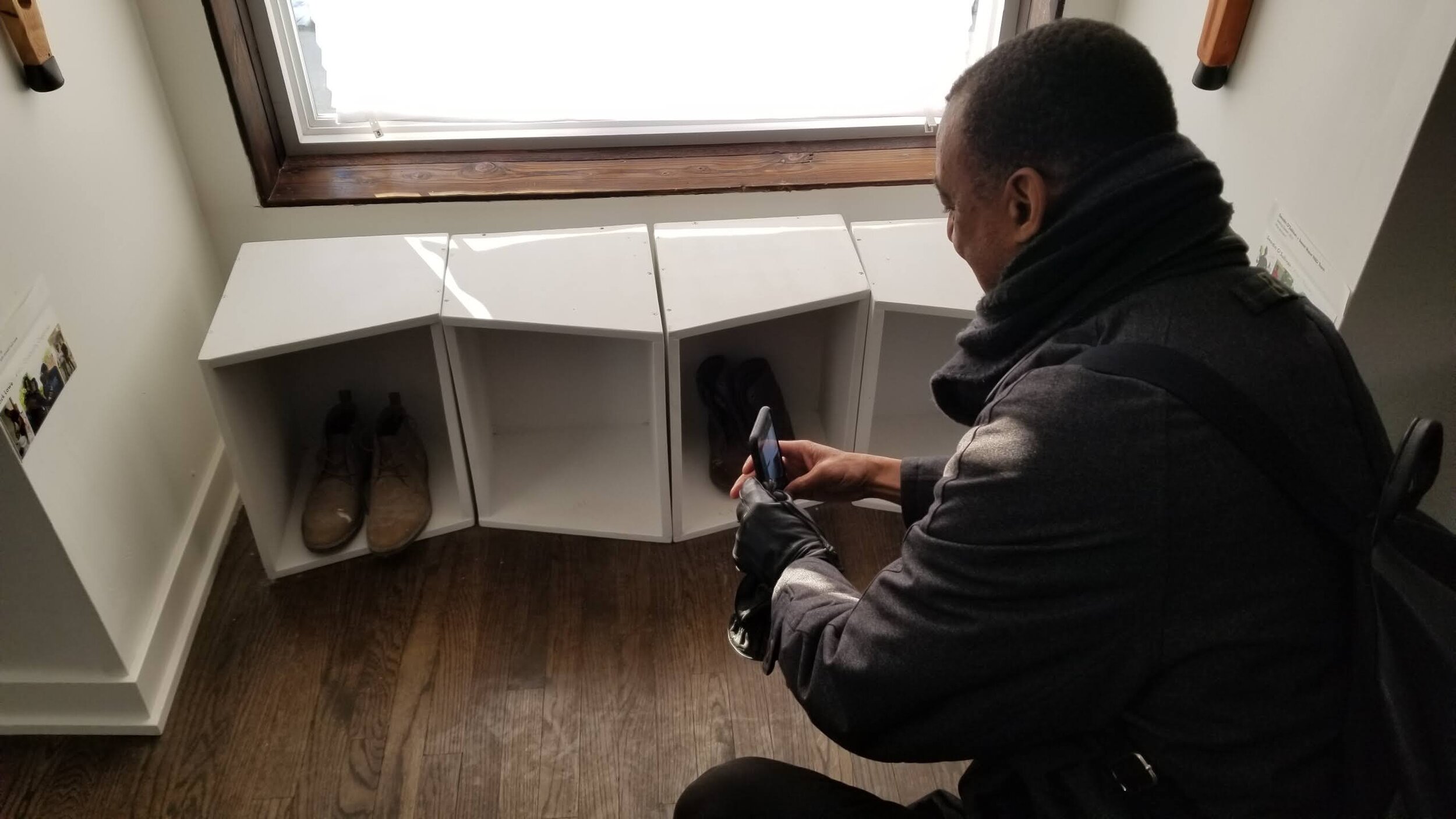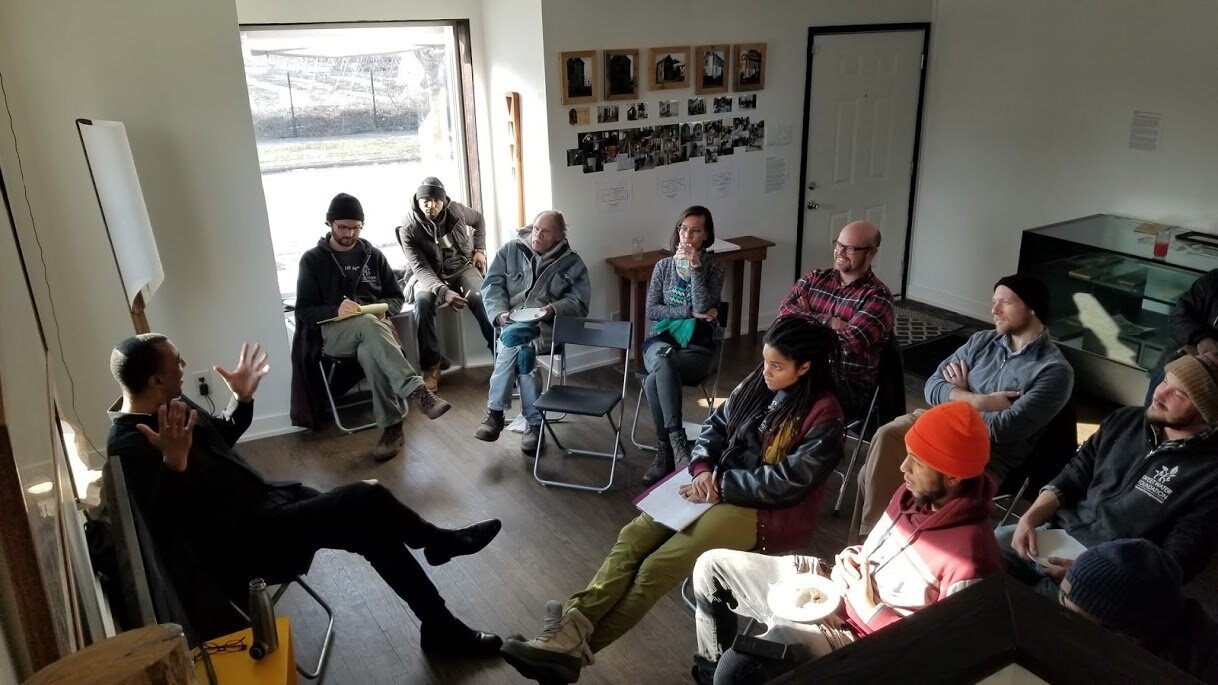Artist Talk | A Conversation with Rick Lowe
On Tuesday, February 11, renowned artist, activist, and MacArthur Fellow, Rick Lowe, joined Emmanuel Pratt for the February Artist Talk at the Gallery at [Re]Construction House. This conversation was the first of a series of talks between Rick and Emmanuel that will be hosted at The Commons in 2020.
During their first conversation, Rick talked about his journey as an artist, activist, builder, and collaborator with Project Row Houses in Houston, Texas and shared a pivotal moment in his life that led him to transition from the mere symbolic and poetic representation of traditional art forms to a practice he refers to as “social sculpture.” More than 25 years since the founding of Project Row Houses, Rick is continuing his practice of social sculpture by contributing his time, labor, and insights to Sweet Water Foundation as a Human-in-Residence. Read on to hear more about the conversation.
From Symbolic and Poetic to Actually Doing Something
In his early years as an artist, Rick’s work focused on large scale paintings that were political in nature. He reflected on one installation, in particular, a large-scale painting in a neighborhood community center that focused on police brutality. The installation was a tremendous success and members of the community were able to use the piece as a platform to bring attention to issues of police brutality via major newspapers and tv outlets.
Amidst the accolades and momentum of the work, the simple words of a teenager who stopped by his studio in Houston shifted the trajectory of his career. The student expressed that while the works were interesting…“We don’t need that. We live in the neighborhood. We know what’s happening. If you’re an artist, why can’t you create a solution?”
“We don’t need that. We live in the neighborhood. We know what’s happening. If you’re an artist, why can’t you create a solution?”
This student caused Rick to take a step back and think about what it means to be an artist and challenged him not only to be an artist that is symbolic, poetic and aspirational, but also one that does work that is real and has practical applications. Rick began to shift his practice to create work “that is just not a representation of something, but is actually doing something.”
During this period of reflection, Rick stumbled upon a book by Joseph Beuys that someone had given him, but which he hadn’t opened for quite some time. He took notice of a chapter entitled, Social Sculpture, and it clicked. Social sculpture is defined as the way in which people shape and mold the world around them. Rick came to believe that “it's important that we think about the energies of human force as being sculpture.” Already steeped in the activist community, Rick realized that “activism can be sculpture” and “we all are sculpting it in one way or another, as something that is beautiful and contributing to the human goals we have, or... sculpting it into something that is destructive.”
This experience and understanding of social sculpture led to Rick’s collaboration on Project Row Houses. Rooted in the Third Ward community of Houston, Texas, the project began in 1993 when seven visionary African-American artists—James Bettison (1958-1997), Bert Long, Jr. (1940-2013), Jesse Lott, Rick Lowe, Floyd Newsum, Bert Samples, and George Smith—recognized real potential in a block and a half on which sat 22 derelict shotgun houses from the 1930s. The group organized the purchase and restoration of the houses into an arts venue, community support center, residential program for young mothers, and more. Project Row Houses has served as an inspiration for Sweet Water Foundation and The Commons. Emmanuel guided the conversation with questions that helped the audience apply Rick’s experiences to the road ahead for the Sweet Water Community, as they seek to grow into the next phase of development at The Commons, which includes construction of new, ground up housing and the rehabilitation of existing homes.
Shotgun Houses and Worker Cottages
Left to right: Project Row Houses Pre-Construction, historic Chicago Worker Cottages, and a Rural Negro School House in Texas.
Having shared the story of what led him to, ultimately, create Project Row Houses, the conversation shifted to the work of Project Row Houses, which centered on a row of 22 shotgun houses. Rick referred to John T. Biggers, an African American artist raised in a shotgun house built by his father in North Carolina, who reflected on the strength of his community growing up and researched to trace the origins of the shotgun house. Rick shared that John T. Biggers discovered that the origins of the shotgun house traced back to West Africa and, through the slave trade, the model made its way to the West Indies, where enslaved peoples had more liberties and were able to construct their own homes in the way they were accustomed to back home. The original model, which was a 12 x 12 square, evolved as families acquired more resources, extending it from a square to an elongated rectangle, keeping the front and back doors lined up - not for the convenience for the shotgun, but for ventilation.
Emmanuel, then, shared images of the typical Chicago Worker Cottage, calling it a “cousin” to the shotgun house. The Chicago Worker Cottage was once the dominant housing typology and the city’s first standardized affordable housing. Emmanuel, then went on to project images of Negro Rural Schools, which were built as part of George Washington Carver and Booker T. Washington’s vision for a new type of education and community center. Both the shotgun house and the Chicago Worker Cottage embody similar aesthetics, innovations, and accessibility for those with limited resources.
Wastes to Resources, Getting the Work Done
Discussion of the shotgun houses, their history, and the possibilities of their transformation turned to one of resources. Rick reflected on how the 22 shotgun houses viewed through the lens of social sculpture presented the opportunity to “rebuild a John Bigger’s painting.” Although his vision was met with many skeptics who believed the project to be too big or those who thought the homes weren’t worth salvaging, Rick was also surrounded by artists who could see the possibility and were willing to do the work. A particular point of inspiration was an 80 year-old woman, who was one of the last remaining residents of the area. Amidst all of the discussion of the possibility of art to transform the block, she said, “Ya’ll want to do something, you need to just clean this [stuff] up.” Rick and his collaborators knew she was right and her words served as inspiration to begin the work, the real work of what would become Project Row Houses.
“Funding is great. But what people don’t think about is what funding really is. Funding is a resource. And once you think of it as a resource, you can ask yourself, ‘what are the other resources?’ Because money is not the only resource.”
The early work of Project Row Houses transpired before the age of computers, so the project was launched with a hand drawn flyer that invited folks near and far to join in the clean up efforts. “We just started cleaning it up with no money.”
Rick shared how, far too often, people get confused or stifled by this idea that you have to have funding. “Funding is great. But what people don't think about is what funding really is. Funding is a resource. And once you think of it as a resource, you can ask yourself, ‘what are the other resources?’ Because money is not the only resource.” Rick, then, shared with the Sweet Water audience how its theme of turning wastes to resources - through the discarded materials of the Chicago Architecture Biennial - is a perfect example of creatively finding resources.
The work of Project Row Houses, similar to the evolution of The Commons, started by just doing the work and focusing on the creative use of both human and material resources that are abundant when there is a collective, shared vision for change.
Sweet Water Foundation is grateful to Rick Lowe for sharing his time and his works with our community. Rick and Project Row Houses is an example of what is possible and serves as a proof point that SWF’s vision for The Commons is attainable. We look forward to the next conversation with Rick in the coming months. There Grows the Neighborhood.












